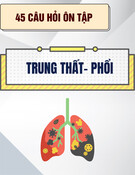
TNU Journal of Science and Technology
229(15): 134 - 142
http://jst.tnu.edu.vn 134 Email: jst@tnu.edu.vn
DEEP LEARNING - POWERED DIAGNOSIS OF PULMONARY DISEASES
VIA X-RAY IMAGING
Dao Thi Le Thuy *
University of Transport and Communications
ARTICLE INFO
ABSTRACT
Received:
17/12/2024
Today, machine learning and deep learning have had many positive
results in helping to diagnose and treat diseases. Based on data,
parameters, and images such as X-ray, ultrasound, and magnetic
resonance imaging, machines can help doctors diagnose and treat
diseases better. This paper presents initial experiments on using deep
learning to identify pulmonary diseases through X-ray image
recognition. In experiments, there were three pulmonary diseases:
aortic enlargement, lung opacity, and another lesion. There were also
cases without disease to identify. The deep learning model with
convolution neural network and DenseNet121 were used for our
experiments with X-ray image data from Vietnamese samples and
provided by VinBigData. The highest average identification accuracy
achieved for pleural thickening and pulmonary fibrosis was 91.68%
using DenseNet121.
Revised:
30/12/2024
Published:
30/12/2024
KEYWORDS
X-ray image
Pulmonary disease
Identification
Convolutional neural network
DenseNet121
HỌC SÂU – CHẨN ĐOÁN BỆNH PHỔI THÔNG QUA HÌNH ẢNH X-QUANG
Đào Thị Lệ Thủy
Trường Đại học Giao thông Vận tải
THÔNG TIN BÀI BÁO
TÓM TẮT
Ngày nhận bài:
17/12/2024
Ngày nay, học máy và học sâu đã đạt được nhiều kết quả tích cực trong
việc hỗ trợ chẩn đoán và điều trị bệnh. Dựa trên dữ liệu, các thông số và
hình ảnh như X-quang, siêu âm và chụp cộng hưởng từ, máy móc có thể
giúp các bác sĩ chẩn đoán và điều trị bệnh tốt hơn. Bài báo này trình bày
các thử nghiệm ban đầu về việc sử dụng học sâu để xác định bệnh phổi
thông qua nhận dạng hình ảnh X-quang. Trong các thử nghiệm, có ba
bệnh lý về phổi bao gồm phình động mạch chủ, đục phổi và một tổn
thương khác. Ngoài ra, cũng có các trường hợp không mắc bệnh để xác
định. Mô hình học sâu với mạng nơ-ron tích chập và DenseNet121 đã
được sử dụng trong các thử nghiệm với dữ liệu hình ảnh X-quang từ các
mẫu bệnh nhân Việt Nam do VinBigData cung cấp. Độ chính xác trung
bình cao nhất đạt được trong việc xác định dày màng phổi và xơ hóa
phổi là 91,68% khi sử dụng DenseNet121.
Ngày hoàn thiện:
30/12/2024
Ngày đăng:
30/12/2024
TỪ KHÓA
Hình ảnh X-quang
Bệnh phổi
Nhận dạng
Mạng nơ-ron tích chập
DenseNet121
DOI: https://doi.org/10.34238/tnu-jst.11728
Email: thuydtl@utc.edu.vn






























